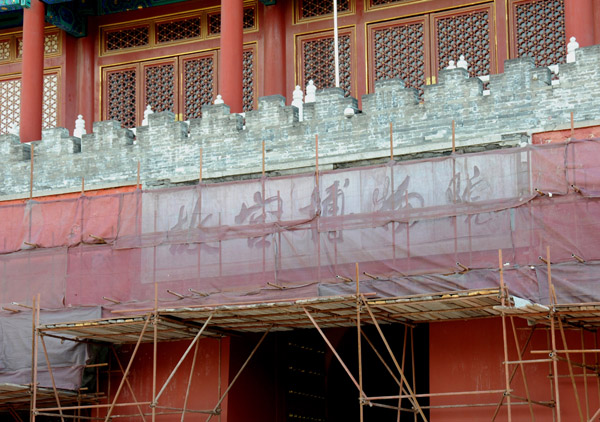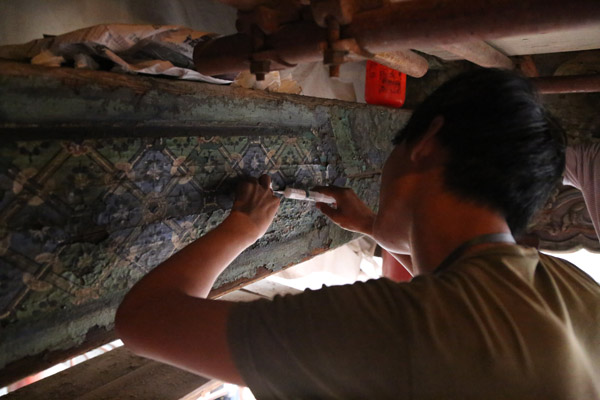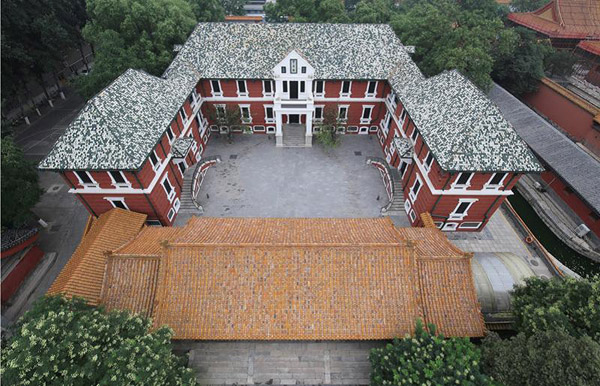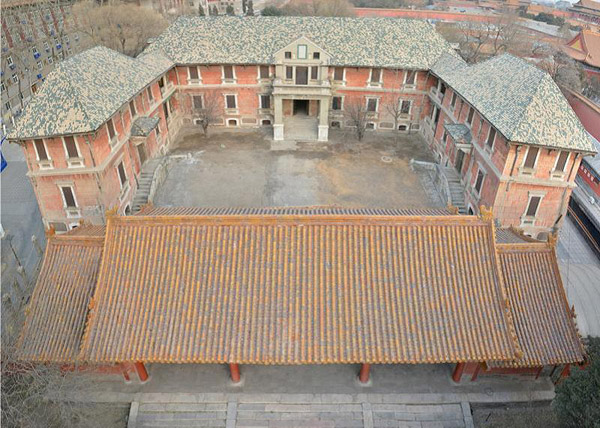Information
More than a brick in the wall

A Palace Museum restoration project wins an award, underscoring the importance of research. Wang Kaihao reports.
Baoyun Lou, or the Hall of Embodied Treasures, stands out among other parts of the Palace Museum, also known as the Forbidden City, which was the seat of power in imperial China.
Inside the complex that occupies 720,000 square meters in the heart of Beijing, the Western-style villa is prominent. It was constructed by the western gate of the Forbidden City as a warehouse for cultural relics in 1914, two years after the monarchy had ended.
On Wednesday, the International Day for Monuments and Sites, Baoyun Lou and five other conservation projects were given this year's award for "outstanding monument restorations in China". The award, which is based on professional assessments and a public poll, is bestowed by the Chinese committee of the Paris-based International Council on Monuments and Sites.
Recalling his experiences of working on the Baoyun Lou project, Wu Wei, an engineer, says the project is a mix of archaeology, historical research and restoration.
"We used digital methods to record all the information held by the architectural components of the hall before we took any more steps."

Wu's team did research in the surrounding areas of Baoyun Lou, which was built up on the foundation of an old palace. The palace was destroyed in a fire in 1912, but the front gate of the courtyard survives. The archaeological research found the gate dates to the Ming Dynasty (1368-1644).
"This is different from what is recorded in files saying the original gate came up since the mid-Qing Dynasty (1644-1911)," Wu says. "We may have more discoveries."
Surprises keep popping up.
For example, the tiles, which Wu describes as "beef tongues" because of their strange shapes, were found to be imported from Germany after he went through records, which indicates that a German architecture firm worked in the Forbidden City in 1914.
"We cannot find any similar counterparts of such tiles in China," Wu says. "It's a pity that we cannot identify the specific workshop that made them."
As a compromise, the team cooperated with a workshop in Tianjin to mimic the original material. New "beef tongues" were made to fix the broken ones.
"But we will make sure these newly added parts are recognizable from the original," Wu says. "We have also left information about where they were produced on the tiles to help the future generations to renovate this place again."
He says the Baoyun Lou project has also created a chance to revitalize disappearing traditional craftsmanship. For instance, some doors of this place were painted in a kind of dye made from ash found at the bottom of cooking pots, but the technique is almost lost today.
"Some restorers had suggested that it be replaced with asphalt, but we stuck to using the old formula," Wu says. "We found the right craftsman in Beijing. That saved the skill from dying."

The Palace Museum began large-scale renovations in 2002, and the plan is to complete most projects by 2020 to mark the 600th anniversary of the Forbidden City.
However, before the Baoyun Lou project, many such projects suffered from the lack of detailed investigation. Nevertheless, the awarded project marked a mindset change for restorers.
The renovation of Dagaoxuan Dian, a Ming-era royal Taoist temple under the administration of the Palace Museum, and Yangxin Dian (the Hall of Mental Cultivation), the residence of the last eight Qing emperors, followed the same disciplines-comprehensive archaeological research, records of historical information and laboratory analysis from the beginning.
"We've seen more renovation projects of heritage sites that make academic research a priority," says Song Xinchao, deputy director of the State Administration of Cultural Heritage, who's also head of the Chinese committee of the International Council on Monuments and Sites. "That is what will be widely promoted nationwide.
"Conservation of the sites cannot be simply treated as construction work. They should be seen as rigid studies. Plans need more evaluation before action is taken."
Old look, new function
In the past decades, a common practice in renovation of historical sites in China has been to give structures a new look, but the winners of the recent award indicate a shifting trend.
"The relics may look as good as 'newborn' after renovation," Du Qiming, an ancient architecture expert and deputy director of Henan Museum, says. "But historical information present in the architecture is also erased through such methods."
He compares the scenario to ancient Chinese paintings.
"Inscriptions left by collectors throughout history are as important as the paintings per se because they show how the art piece got circulated," Du says.
"It is also suitable for old architecture. The broken parts with abundant information should be kept. They are part of history."

In the case of Baoyun Lou, 140 old bricks were planned to be replaced by new ones at first, but Wu's team found that some broken bricks were usable after being fixed. Only 20 bricks were replaced in the end.
"The principle of minimum intervention was thus used to preserve its genuine historical value," Song adds. "And all renovations should be reversible in case wrong decisions are made."
He also emphasizes that old architecture has to be better used after conservation to prolong its life.
Baoyun Lou sets a good example as a reception room for the Palace Museum.
It is now used as an exhibition venue to review the history of the Forbidden City after it became a museum in 1925. Its courtyard was a stage featuring Treasure the Treasures, an original historical play created by the museum's staff. And it was also a venue for a summit of leaders from China and the United States in November.
Dilemma to be solved
Problems still haunt conservation efforts in China.
At a news conference outside Baoyun Lou on April 16, Shan Jixiang, director of the Palace Museum, said the compulsory bidding system for the conservation has created a threshold.
"Rules demand that the projects introduce market competition," he says. "That will lead the cheapest plans to be favored. However, regular construction workers lack rigid training in professional conservation."
It also leads to modern construction materials being used instead of the originals.
"There is a huge gap in quality," Shan says. "Sometimes, they even don't match at all."
A good thing is: With more academic studies being introduced to conservation work at the museum, a certification system has been established in recent years to ensure all restorers within the Forbidden City are trained properly.
But the lack of tailored materials for conservation remains a bottleneck. Consequently, the Palace Museum is now building connections with regions that supplied construction materials in the imperial years.
Jin Jin from Suzhou, Jiangsu province, is the sixth generation in her family to use traditional techniques to make bricks. The kiln she lived by used to provide the "gold bricks" for the Forbidden City in the Ming Dynasty.
The so-called gold bricks were not actually made of gold but were of top quality and were exclusively used for palaces in ancient China. It sounded like metal when stacked.
According to Jin, one such brick, more than 1 square meter, will take almost one year to produce following 29 steps. After many trials, her workshop successfully made bricks with quality close to the ancient ones. On April 16, it was announced that the workshop had reached an agreement with the Palace Museum to provide 100 such bricks in the next three years.
The cost is sponsored by Taihu World Cultural Forum, which also paid for the Palace Museum to order 1 million pieces of gold foils from a Nanjing workshop for future renovations.
"We can hand over these precious materials ... for the sake of future generations," Shan says.
Category: English
News
Information
Key words:
